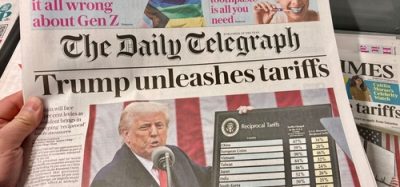The bitter taste of honey analysis
- Like
- Digg
- Del
- Tumblr
- VKontakte
- Buffer
- Love This
- Odnoklassniki
- Meneame
- Blogger
- Amazon
- Yahoo Mail
- Gmail
- AOL
- Newsvine
- HackerNews
- Evernote
- MySpace
- Mail.ru
- Viadeo
- Line
- Comments
- Yummly
- SMS
- Viber
- Telegram
- Subscribe
- Skype
- Facebook Messenger
- Kakao
- LiveJournal
- Yammer
- Edgar
- Fintel
- Mix
- Instapaper
- Copy Link
Posted: 24 November 2020 | Chris Elliott | 5 comments
Professor Chris Elliott questions the validity of a recent article which claimed widespread honey fraud in the UK and calls for regulators and Government to make strides towards better testing methods.


Over the weekend I read two articles about honey fraud. The first claimed that there was widespread adulteration of honey on sale in UK supermarkets. The second claimed there was widespread adulteration of honey in the Indian markets. I believed one of these reports but not the other; not because of any bias towards the UK food industry, but rather, based on my own knowledge of the subject, I imagine the former to be highly unlikely.
Moreover, I know that the scourge of food adulteration is a massive issue in India, so I am fairly confident that that report was an accurate reflection of the situation there.
Solid data
So why am I am the ‘doubting Thomas’ around the UK data? Well, there’s two reasons for this.
The first is the outstanding work on the Food Industry Intelligence Network (fiin). Established in 2015, fiin was created following my independent report to the Government to help ensure the integrity of food supply chains and protect the interests of the consumer. The network collects more authenticity testing data than any other country in the world I am aware of; more than 50,000 tests results each year. As honey is a well-known adulterated food, the number of samples tested in quite high, and to the best of my knowledge, there has never been a sample shown to be the subject of adulteration.
My second reason for doubting, is the unbelievable complications around honey. It is a very complex substance, produced in many countries and in many varieties based on the source of nectar the bees feed on. Honeys on sale can be from a single source or – as they are quite often – as blends of several types. There are nearly as many types of testing methods for honey as there are honey types. The scientific literature is full of such methods and in one quick search, I found well over 100 scientific publications on the topic.
In the report that claimed widespread honey fraud was prevalent in the UK, the technique that was employed to identify the adulterated product was Nuclear Magnetic Resonance (NMR) spectroscopy. This is a very elegant technique; to do it with a high enough degree of confidence takes a huge amount of work. A massive database of honey samples collected and tested from many different countries, production methods, seasons etc., is needed. To give an example, the detection of wine fraud is very much based on NMR and there are currently over 25,000 samples in the EU database. I very much doubt the honey database that this German company (which offers the NMR), is on this scale – or even close to it.
There was a UK Government sponsored workshop on the technique last year, specifically around honey and the main conclusion was: interesting technique but too early days to use… This is also my opinion, and where non-complaint results are found, this indicates that supply chains should be investigated and certainly not claims of adulteration announced.
Final thoughts
If honey analysis is so difficult, why do I believe the results from India? I track food fraud around the world and by far, India reports the most problems. Unfortunately, there appears to be a culture of cheating in some areas of their food industry. In addition, the adulteration is generally not sophisticated and can often involve the use of low-grade sugars and industrial dyes.
So where does this all leave us in the UK? I believe it’s time for the regulators (eg, FSA and DEFRA) and fiin to work more closely together in an effort to devise more robust testing methods for honey. I firmly believe there are technology solutions for this and they will provide the level of certainly needed around honey authenticity, protect the public, and stop reports that can damage the food industry and lose the hard earned trust of UK consumers.
Related topics
Related organisations
Department for Environment Food and Rural Affairs (Defra), Food Industry Intelligence Network (FIIN), Food Standards Agency (FSA)










At Bruker, we fully agree with the importance of the size and quality of the databases used by analytical testing methods. That is why we have invested a tremendous amount of work to develop a robust and reliable NMR-based testing method, which relies on a huge and global database of 18.000 well-characterized honeys, representative of the complexity of honey and covering many different countries, seasons, production years, floral sources, blends and production modes, etc.
We are working closely together with experts in the honey field around the world and are cooperating with regulators from various countries, which are given the access to the Database in order to validate it and use it for official purposes. Together with them, we strive to further improve the testing method to detect new adulteration methods, which are not visible by traditional analytical methods.
In this spirit, the database is constantly growing, and we will soon release a powerful update of the method.
Lea Heintz, Product Manager FoodScreener
Thomas Spengler, Market Manager Food
Bruker BioSpin GmbH
Dear Pr Elliott,
to the best of my knowledge beekeeping in UK is not really widespread due to the climate.
Which countries does UK mainly import honey from and how much does India count into it ?
Best Regards,
Kate
Honey fraud has been widely documented in many parts of the world for a long time! I’m very aware of this and the many different ways the fraud is perpetrated. I also believe there is a lot of fake or at least blended honeys on the market in many countries as I write this. My issue is not with NMR but if the article is read carefully it’s about the size of the database that is used. I build such databases for at least part of my living and I know how big a job it is and if all types of honey (in this case) are not included then it can trigger false results. I have blind trust in nothing including analytical tests.
Chris Elliot concludes from imagination and experience. Honeyauthenticityproject.org from analysis results to 23 honey jars bought at main 10 UK retailers. Over 232 analysis show failures in all 3 main analysis categories, either showing low biological honey markers, fraud markers foreign to honey or failure of complex and expensive generic methods like NMR and HRMS that scrutinize at once a minimum of 3 dozens of components by spectrometry. All Jars have compliant reports from LC-EAIRMS method which compares isotopic ratios within 4 types of carbohydrates, honey and pollen. In its founding article, this method justifies the purity of its data base of 450 authentic honey samples with analysis determinations that all of the jars in the UK retail *actually failed*. Further more and contrary to relying in imagination, initially guided for impossibly cheap price levels, the HAP jars experiment results became complaints brought to UK Trade Standards Offices in Brighton and Hove for 8 jars, Kingston 2 jars and Richmond only one Tesco jar. Only the latter complaint was honored and commissioned by London Boroughs of Merton & Richmond to Public Analyst Scientific Services Ltd, in the UK. The adulteration conclusions are overwhelming in extent. It can be presumed that a fake passport to sea containers filled with international honey fraud is the LC EAIRMS report, very likely used as only authentication analysis. Facts and proofs not hunches. Two big impacts of honey fraud deserve combat honey fraud in deep: damage to real beekeepers, the front liners saving bees from deforestation, plagues and pesticides. Consumers, eating a dead sweetener is very different health wise than wonderful honey,
This is a most curious commentary from a number of standpoints.
There is significant evidence that there is widespread fraud in honey. The report by FoodQS https://www.foodqs.de/ that was just released is by no means the first evidence of considerable honey fraud in Europe or the world.
https://www.vice.com/en/article/884kq4/your-fancy-honey-might-not-actually-be-honey
https://www.abc.net.au/news/2018-09-03/capilano-and-supermarkets-accused-of-selling-fake-honey/10187628
https://www.cbc.ca/news/canada/toronto/food-fraud-fake-honey-cfia-crackdown-1.5222486
https://www.netflix.com/ca/title/80146284 Season 1 Episode 1
What is also interesting in this opinion piece is his dismissal of the honey NMR system by using the wine NMR system. This is particularly ironic in that both systems are provided by the same company (Bruker Biospin) and performed on the same equipment. In addition, one of the major consultants used by FoodQS is Stephan Schwarzinger (https://www.researchgate.net/profile/Stephan_Schwarzinger) who is one of the major developers of both the wine and honey NMR protocols. He comments on the need for a large database mentioning the number 25,000 in relation to wine. In fact, the honey database is currently in excess of 20,000 samples and a new version will be released soon that will increase that number substantially. When this happens the data can be compared against the new system.
It is also interesting that Professor Elliot believes there is widespread fraud in India. There is considerable evidence that this is also the case, but it is the widespread fraud in many countries that is the source of the fraud in Europe and around the world.
Norberto Garcia and Ron Phipps have extensively documented incongruities in honey exports and have shown this.
https://www.tandfonline.com/doi/abs/10.1080/0005772X.2018.1483814
As Doubting Thomas was eventually convinced by evidence, I hope that this introduction to honey fraud will show Professor Elliot that blind trust in regulatory bodies is not wise. These bodies are underfunded and only have resources to focus on blatant fraud that often involves harm and need strengthening if they are to withstand the onslaught of fraudulent foods.